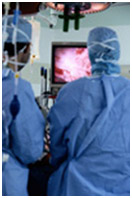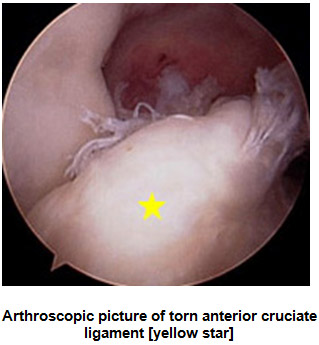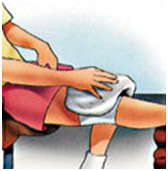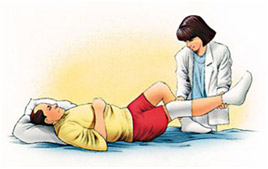Knee Arthroscopy
Arthroscopy is a common surgical procedure in which a joint (arthro) is viewed (scopy) using a small camera. Arthroscopy gives doctors a clear view of the inside of the knee. This helps them diagnose and treat knee problems.
Technical advances have led to high definition monitors and high resolution cameras. These and other improvements have made arthroscopy a very effective tool for treating knee problems.
Description
Arthroscopy is done through small incisions. During the procedure, your orthopaedic surgeon inserts the arthroscope (a small camera instrument about the size of a pencil) into your knee joint. The arthroscope sends the image to a television monitor. On the monitor, your surgeon can see the structures of the knee in great detail.
Your surgeon can use arthroscopy to feel, repair or remove damaged tissue. To do this, small surgical instruments are inserted through other incisions around your knee.

Preparing for Surgery
If you decide to have knee arthroscopy, you may need a complete physical examination by your orthopaedic surgeon and his/her team to assess your health and identify any problems that could interfere with your surgery.
Before surgery, tell your orthopaedic surgeon if you are taking medications or supplements. He or she will tell you which medicines you must stop taking before surgery.
To help plan your procedure, your orthopaedic surgeon may order pre-operative tests. These may include blood counts or an ECG (electrocardiogram).

Surgery
You may go home the same day or otherwise spend one night in hospital depending on a number of factors.
Arrival
Your hospital will contact you with specific details about your appointment. You will likely be asked to arrive at the hospital a few hours before your surgery. You should not eat anything for 8 hours and should not drink for 6 hours before your surgery.
Anaesthesia
When you first arrive for surgery, an anaesthetist will talk with you. Arthroscopy can be performed under local, regional, or general anaesthesia.
• Local anaesthesia numbs just your knee
• Regional anaesthesia numbs you below your waist
• General anaesthesia puts you to sleep
The anaesthetist will help you decide which method would be best for you.
If you have local or regional anaesthesia, you may be able to watch the procedure on a television monitor.
Procedure
The orthopaedic surgeon will make a few small incisions in your knee. A sterile solution will be used to fill the knee joint and rinse away any cloudy fluid. This helps your orthopaedic surgeon see your knee clearly and in great detail.

Your surgeon’s first task is to properly diagnose your problem. He or she will insert the arthroscope and use the image projected on the screen to guide it. If surgical treatment is needed, your surgeon will insert tiny instruments through another small incision. These instruments might be scissors, motorized shavers, or graspers.
This part of the procedure usually lasts 30 minutes to over an hour. How long it takes depends upon the findings and the treatment necessary.
Arthroscopy for the knee is most commonly used for:
• Removal or repair of torn meniscal cartilage
• Reconstruction of a torn anterior cruciate ligament
• Trimming of torn pieces of articular cartilage
• Removal of loose fragments of bone or cartilage
• Removal of inflamed synovial tissue
Your surgeon may close your incisions with a stitch or steri-strips (small band aids) and cover them with a soft bandage.
You will be moved to the recovery room and should be able to go home within 1 or 2 hours unless you are spending one night in hospital. Be sure to have someone with you to drive you home.
Recovery
Recovery from knee arthroscopy is much faster than recovery from traditional open knee surgery. Still, it is important to follow your orthopaedic surgeon’s instructions carefully after you return home. You should ask someone to check on you the first evening you are home.
Swelling
Keep your leg elevated as much as possible for the first few days after surgery. Apply ice as recommended by your doctor (usually 20 minutes every 2 hours) to relieve swelling and pain.

Dressing Care
You will leave the hospital with a dressing covering your knee. Keep your incisions clean and dry. Your surgeon will tell you when you can shower or bathe, and when you should change the dressing.
Your surgeon will see you in the office a few days after surgery to check your progress, review the surgical findings, and begin your postoperative treatment program.
Bearing Weight
Most patients need crutches or other assistance after arthroscopic surgery. Your surgeon will tell you when it is safe to put weight on your foot and leg. If you have any questions about bearing weight, call your surgeon.
Driving
Your doctor will discuss with you when you may drive. This decision is based on a number of factors, including:
• The knee involved
• Whether you drive an automatic or manual
• The nature of the procedure
• Your level of pain
• Whether you are using narcotic pain medications
• How well you can control your knee.
Typically, patients are able to drive from 1 to 3 weeks after the procedure.
Medications
Your anaesthetist will prescribe pain medication to help relieve discomfort following your surgery. He or she may also recommend medication such as aspirin to lessen the risk of blood clots.
Exercises to Strengthen Your Knee
You should exercise your knee regularly for several weeks after surgery. This will restore motion and strengthen the muscles of your leg and knee.
Therapeutic exercise will play an important role in how well you recover. A formal physiotherapy program may improve your final result.

Complications and Warning Signs
As with any surgery, there are risks associated with knee arthroscopy. These occur infrequently and are minor and treatable.
Complications
Potential postoperative problems with knee arthroscopy include:
• Infection
• Blood clots
• Accumulation of blood in the knee
Warning Signs
Call your orthopaedic surgeon or your local doctor immediately if you experience any of the following:
• Fever
• Persistent or increased pain
• Significant swelling in your knee
• Increasing pain in your calf muscle
Outcome
Unless you have had a ligament reconstruction, you should be able to return to most physical activities after 6 to 8 weeks, or sometimes much sooner. Higher impact activities may need to be avoided for a longer time. You will need to talk with your doctor before returning to intense physical activities.
If your job involves heavy work, it may be longer before you can return to your job. Discuss when you can safely return to work with your doctor.
The final outcome of your surgery will likely be determined by the degree of damage to your knee. For example, if the articular cartilage in your knee has worn away completely, then full recovery may not be possible. You may need to change your lifestyle. This might mean limiting your activities and finding low-impact exercise alternatives.